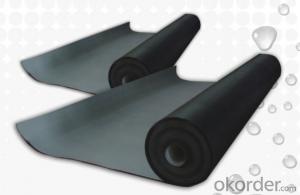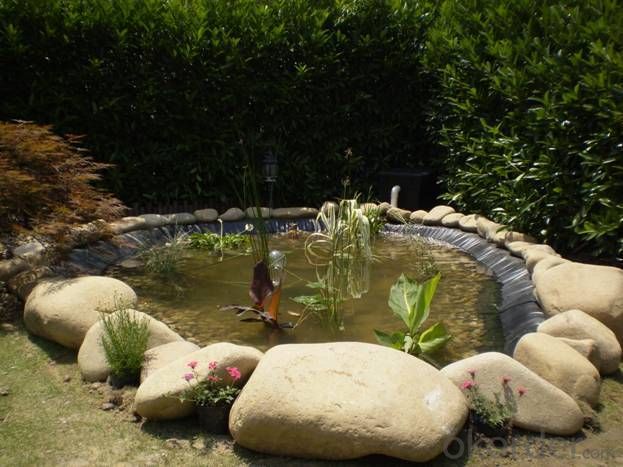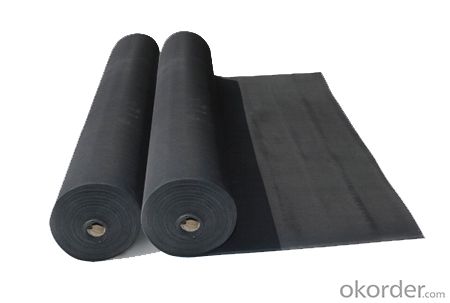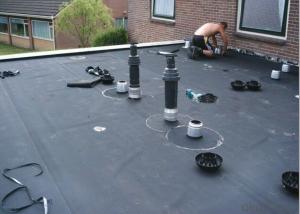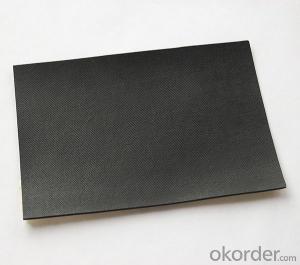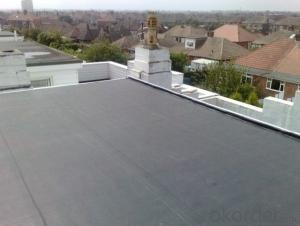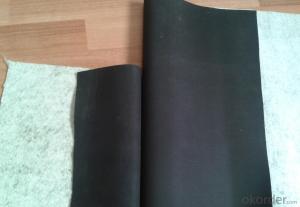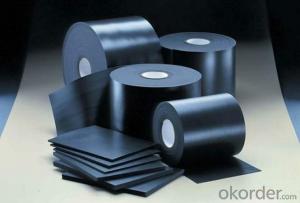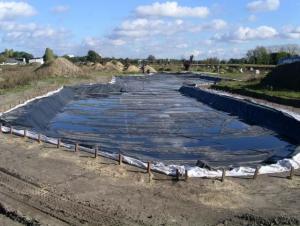EPDM Rubber Coiled Waterproof Membrane for Multi Function
- Loading Port:
- Shanghai
- Payment Terms:
- TT OR LC
- Min Order Qty:
- 50000 m²
- Supply Capability:
- 5000000 m²/month
OKorder Service Pledge
OKorder Financial Service
You Might Also Like
EPDM Rubber Coiled Waterproof Membrane for Multi Function
Description Of EPDM Rubber Coiled Waterproof Membrane for Multi Function:
•EPDM waterproof sheet has excellent anti-ozone-aging performance, able to resist ultraviolet light and corrosion of many chemical corrosive materials in the atmosphere
•It has high tensile strength, high ductility and strong retractility, it has excellent crack resistance, able to effect waterproof function even with tiny vibration of buildings.
• Excellent resistance to ozone, oxidation and sunlight.
• Resistance to chemicals; resistant to most inorganic products.
Main Features of EPDM Rubber Coiled Waterproof Membrane for Multi Function:
1>Excellent antiaging performance, service life up to 50 years
2>Working well with in 40C to 100C,it canbe constructed with a single layer in ambient temperature.
3>Waterproofing on various kinds of underground project,industrial of civil buildings and structures.
4>high extension rate, high tensile strength, small size changes at heat treatment
5>Good plant roots penetrability resistance and can be made waterproofing layer of planting roof
6>Special modified molecular structure ,effectively resolving the current domestic and foreign glue joint problem.
7>Good low temperature flexibility, and good performance of adapting to ambient temperature changes.
8>Convenient application ,solid joint, no environment pollution
9>chemical corrosion Resistance, can be used for special occasions
10>Convenient maitenance, low cost.
Specifications of EPDM Rubber Coiled Waterproof Membrane for Multi Function:
| Material | EPDM Rubber |
| Size | 1.2m (width)*20m (length) or customized, weldable type 2.05m or 4m width |
| Thick | 1.2mm, 1.5mm, 2.0mm |
| Type | Vulcanized & Weldable |
| Pattern | Non-reinforced (homogeneous) |
| Certificate | ISO9001/14001 |
Applications of EPDM Rubber Coiled Waterproof Membrane for Multi Function:
Widely used in roofs, basement, toilet ,swimming pool, and all kinds of industry and civil building waterproofing, reservoir, vivicism, bridge, underground, tunnel and dam waterproofing ,especially to the keystone waterproofing projects which is durability, high corrosion resistance and easy deformation.



IMages of EPDM Rubber Coiled Waterproof Membrane for Multi Function:




FAQ of EPDM Rubber Coiled Waterproof Membrane for Multi Function:
1. What are we supplying?
We are specialized in producing Colorful Asphalt Roof Shingle, SBS/APP modified bitumen waterproof membrane, Self adhesive bitumen waterproof membrane, PVC waterproofing membrane, EPDM rubber roofing membrane, Single Component Polyurethane Waterproof Coating, and Spray Polyurea Waterproof Coating
.
2. How Many years experience do we have?
We have been exported to more than 20 countries in the past 15 years.
3. How long do we usually reply your request?
We always reply our customer within 24 hours.
- Q: Can a waterproofing membrane be used for exterior foundation walls?
- Yes, a waterproofing membrane can be used for exterior foundation walls. Waterproofing membranes are specifically designed to provide a barrier against water penetration and can be applied to the exterior surface of foundation walls to prevent moisture infiltration. This helps in protecting the foundation from potential damage caused by water, such as leaks, cracks, and deterioration.
- Q: Can waterproofing membranes be used on foundation walls?
- Indeed, it is possible to utilize waterproofing membranes on foundation walls. These membranes possess a specific design that aims to impede the infiltration of water and are commonly employed on foundation walls to safeguard against moisture and water-related harm. Typically, these membranes consist of resilient materials like rubberized asphalt, thermoplastic, or PVC, which exhibit durability and resistance to water penetration. The installation of these membranes occurs on the outer side of the foundation walls, thereby serving as a highly efficient barrier against water, effectively averting its seepage into the basement or crawl space. Without a doubt, waterproofing membranes constitute an indispensable element in the realm of building construction, as they actively contribute to the preservation of the foundation's structural integrity, preventing adverse consequences such as water damage, mold growth, and foundation settlement.
- Q: Are there any specific requirements for installing a waterproofing membrane?
- Yes, there are specific requirements for installing a waterproofing membrane. These requirements may vary depending on the type of membrane being used and the specific application. However, some general requirements include: 1. Surface Preparation: The surface where the membrane will be installed must be clean, dry, and free from any dust, debris, or contaminants. Any cracks or defects in the surface should be repaired prior to installation. 2. Adhesive or Bonding Agent: Depending on the type of membrane, an adhesive or bonding agent may be required to ensure proper adhesion to the substrate. This adhesive should be compatible with both the membrane and the substrate. 3. Primer: In some cases, a primer may be necessary to enhance the adhesion between the substrate and the membrane. The type of primer required will depend on the specific membrane and substrate being used. 4. Seam and Joint Preparation: Properly preparing seams and joints is crucial to ensure a watertight installation. This may involve using a specific sealant or tape to reinforce the seams and prevent water penetration. 5. Installation Techniques: The membrane should be installed according to the manufacturer's instructions and industry best practices. This may include using a specific method such as torching, hot air welding, or cold adhesive application. 6. Overlaps and Transitions: Properly overlapping the membrane sheets and ensuring smooth transitions between different areas is essential for a successful installation. This will help prevent water from seeping through gaps or weak points in the membrane. 7. Quality Control: Regular inspections and quality control measures should be implemented throughout the installation process to ensure that the membrane is being installed correctly and meets the required standards. It is important to consult the manufacturer's guidelines and specifications for the specific waterproofing membrane being used, as different membranes may have unique installation requirements. Additionally, local building codes and regulations should also be considered to ensure compliance and to meet any specific requirements in your area.
- Q: Can a waterproofing membrane be used in boat decks or marinas?
- A waterproofing membrane is capable of being used in boat decks or marinas. Boat decks and marinas are subjected to constant water exposure, which makes them vulnerable to deterioration and damage over time. To protect these surfaces from water intrusion, a waterproofing membrane offers an effective solution. This prevents issues like rotting, warping, and the growth of mold. Acting as a barrier, the membrane prevents water from seeping into the underlying structure and causing harm. Moreover, it helps maintain the structural integrity of boat decks or marinas, thus extending their lifespan. Furthermore, the use of a waterproofing membrane enhances safety by reducing the risk of slip and fall accidents through the provision of a slip-resistant surface. All in all, opting for a waterproofing membrane for boat decks or marinas is a smart decision to ensure durability, longevity, and safety.
- Q: Can a waterproofing membrane be used for mechanical rooms?
- A waterproofing membrane is suitable for mechanical rooms where various equipment and systems are housed. These rooms require protection from water damage. Waterproofing membranes create a barrier that prevents water from penetrating the structure, which could potentially harm the mechanical equipment. To ensure a watertight environment that extends the lifespan of the equipment and reduces the risk of water-related issues, apply the waterproofing membrane to the walls, floors, and even ceilings of the mechanical room. Moreover, waterproofing membranes also safeguard against other forms of moisture, such as condensation or high humidity levels, which can negatively impact the functionality of mechanical systems. In conclusion, utilizing a waterproofing membrane in mechanical rooms is a practical and effective method to safeguard the equipment and maintain a dry and operational environment.
- Q: Can a waterproofing membrane be used for underground parking garages?
- Yes, a waterproofing membrane can be used effectively for underground parking garages. These membranes are specifically designed to provide a protective barrier against water infiltration, preventing damage to the structure and ensuring a dry and safe environment for vehicles.
- Q: Can a waterproofing membrane be used on both horizontal and vertical surfaces of a structure?
- Yes, a waterproofing membrane can be used on both horizontal and vertical surfaces of a structure. Waterproofing membranes are designed to create a barrier against moisture and are commonly used in various applications such as roofs, basements, foundations, balconies, and walls. They are flexible and can adapt to different surface orientations, making them suitable for both horizontal and vertical installations. The membrane's flexibility allows it to be easily applied and adhere to different surfaces, providing effective protection against water infiltration and potential damages caused by moisture. Whether it is applied on a horizontal surface like a roof or a vertical surface like a wall, a waterproofing membrane can help maintain the integrity and longevity of a structure by preventing water penetration and potential water-related issues.
- Q: How does a waterproofing membrane handle hydrostatic pressure?
- A waterproofing membrane handles hydrostatic pressure by acting as a barrier between water and the structure it is applied to. When exposed to hydrostatic pressure, which is the pressure exerted by standing or moving water, the membrane forms a continuous seal that prevents water from penetrating into the structure. The membrane is designed to be impermeable, meaning that it does not allow water molecules to pass through it. It is typically made of materials such as rubber, PVC, or bitumen that have high resistance to water penetration. These materials are also flexible, allowing the membrane to conform to the contours of the surface it is applied to and provide a tight seal. When hydrostatic pressure is applied to the membrane, it resists the force and prevents water from infiltrating the structure. The membrane's resistance to water pressure is a result of its thickness, strength, and the quality of its installation. Thicker membranes are generally more resistant to hydrostatic pressure, while a properly installed membrane with no gaps, voids, or overlaps enhances its effectiveness in handling water pressure. In addition to providing a barrier against water penetration, some waterproofing membranes are also designed to accommodate movement caused by hydrostatic pressure. They can stretch or elongate to accommodate the expansion and contraction of the structure due to varying water levels or other external forces. This flexibility helps the membrane maintain its integrity and prevent water from seeping through. Overall, a waterproofing membrane effectively handles hydrostatic pressure by providing a continuous, impermeable barrier that resists the force of standing or moving water and prevents it from infiltrating the structure. Its ability to withstand water pressure is dependent on its thickness, strength, installation quality, and flexibility to accommodate movement.
- Q: Can a waterproofing membrane be used in conjunction with vapor barriers?
- Using both a waterproofing membrane and vapor barriers together is highly recommended to provide thorough protection against moisture. Waterproofing membranes effectively block water from penetrating surfaces like roofs or foundations, while vapor barriers prevent the passage of water vapor. By utilizing both, you can prevent both liquid water and water vapor from causing any harm to a structure. The waterproofing membrane acts as a physical barrier, ensuring that water cannot enter, while the vapor barrier stops moisture buildup within the structure. This combination is especially advantageous in regions with high humidity or areas at risk of water intrusion.
- Q: Does a waterproofing membrane provide any soundproofing benefits?
- No, a waterproofing membrane does not provide any soundproofing benefits. Its primary function is to prevent water penetration and protect against moisture damage. Soundproofing requires specific materials and techniques designed to absorb, block, or isolate sound waves.
Send your message to us
EPDM Rubber Coiled Waterproof Membrane for Multi Function
- Loading Port:
- Shanghai
- Payment Terms:
- TT OR LC
- Min Order Qty:
- 50000 m²
- Supply Capability:
- 5000000 m²/month
OKorder Service Pledge
OKorder Financial Service
Similar products
Hot products
Hot Searches
Related keywords
